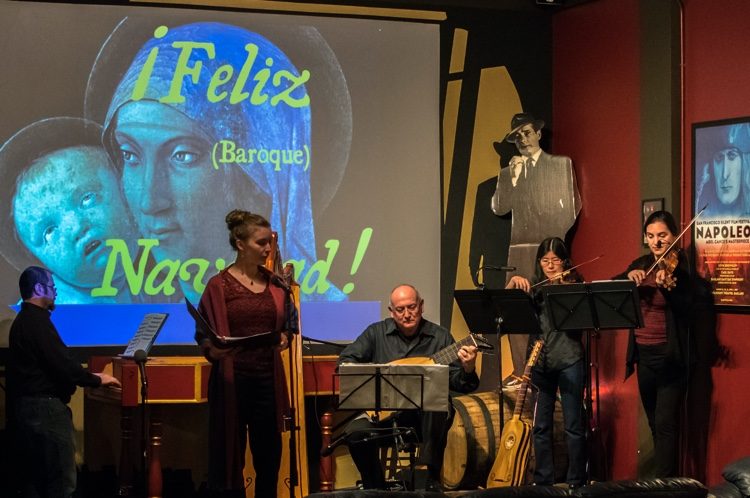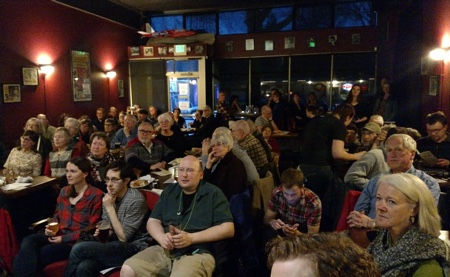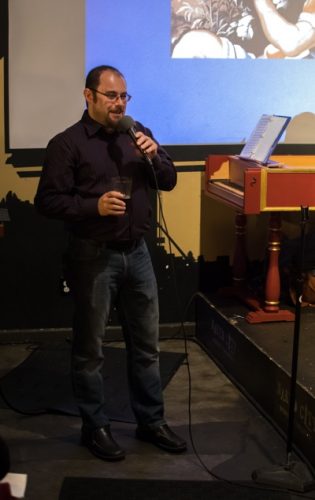
(Photo by Emmeran Pokorny)
By Philippa Kiraly
SEATTLE — There’s a reason this city’s Pacific MusicWorks Underground has titled its January concerts “All that (Baroque) Jazz.” At the start of the 17th century, a musical ferment was pushing previously understood boundaries. It was experimental, harmonically, and rhythmically adventurous — think Monteverdi’s Orfeo of 1607 spearheading a completely new genre — just as now.
For the past century, the same has been happening with a musical explosion in all directions: pop, rock, rhythm and blues, country, hip hop, rap, grunge, ragtime, jazz, folk, classical, and more. The mix has included everyone from Scott Joplin, Duke Ellington, the Beatles, Dolly Parton, and Jimi Hendrix to composers like John Cage and John Luther Adams, whose 2013 orchestral work Become Ocean is unlike any prior classical composition.
Whereas music in the 17th century came from across the board, audiences today tend to listen only to their preferred genre. “People’s comfort zones are getting narrower and narrower,” says Underground’s director, Henry Lebedinsky, whose mission is to expand those zones through performances in unexpected places, with no compromising on the quality of the music.

“Much of 17th-century music was pop songs with a riff on them, so we’ll give them a taste of the pop song and then play the instrumental music,” he says of the Baroque Jazz concert. He’s included music of Polish composers of the day: “It’s largely unknown, stunningly virtuosic, and great fun,” but, as at every concert, Lebedinsky has programmed at least one composer everybody will recognize.
“Fun” has a lot to do with what Underground concerts are all about. The 42-year-old Lebedinsky, an organist and choirmaster, harpsichordist and repairer, and mover and shaker, moved to Seattle in 2014. Shortly thereafter, he began what was called Early Music Underground, a series of chamber concerts in informal venues designed to appeal to younger audiences.
Since he likes to have a drink and a good time and enjoy music in a pleasant setting, Lebedinsky decided he would set about creating just that for these performances. Underground presents about 40 concerts a year around the greater Seattle area at places like a brewery or winery, a pub, or an event room in an apartment building. Each program is repeated three or four times over the course of a few days.
At each location, there’s something inviting to get people involved, whether it’s a drink or coffee or maybe multimedia. Each program has a catchy title to draw listeners in, like the “Vivaldi in the Vineyard” program that blends the Italian composer’s music — fiery, passionate, heartfelt — with Italian-style wines. “We’re trying to sell what we’re doing by hooks or concepts, not trying to sell them a Requiem.”
Early music is only part of Lebedinsky’s life. “Half my career is Irish folk music. I am in a hall with 1,000 people and I’m rocking my heart out. OK, when I sit at my harpsichord, how can I make this happen again and be genuine and authentic and still give the audience a good show?”
Shortly after arriving in Seattle, he met with August Denhard, executive director of the city’s venerable Early Music Guild (now Early Music Seattle). They talked about aging listeners and donors and agreed it was essential to reach potential audience members at a much younger age, simply from the point of self-preservation. “In 20 years, there won’t be anyone out there. We have to reach them earlier.”
After a year as an affiliate of EMG, which helped get the word out about what Lebedinsky’s group was doing, Underground joined forces in 2016 with Stephen Stubbs’ Pacific MusicWorks as its outreach arm. With the new name Pacific MusicWorks Underground, Lebedinsky has forged ahead.
Working together has benefits for both organizations. They discuss dates in order not to clash. While Underground tends mostly to use the Seattle area’s excellent period-music performers, it also has access to national and international artists who come to work on programs with Stubbs. At the same time, Underground feeds audiences into the Pacific MusicWorks concerts, which take place in venues such as St. Mark’s Cathedral in a much more classical-program atmosphere. At both series, the other is advertised, usually with Lebedinsky or Stubbs speaking at the start of a program.

Lebedinsky is passionate about trying to get the word — or rather, the sound — of Baroque music out to wider audiences. His latest venture is a series of downtown Seattle lunchtime concerts in the beautiful Christ Our Hope Catholic Church carved out of a remodeled ballroom at the Josephinum, a one-time, century-old luxury hotel that houses apartments for low-income people and is close to a hive of Amazon workers. Called Sanctuary in the City, the lunchtime concerts are shortened versions of Underground programs, and use the same performers. The concerts are free and open to everyone, with a donation basket discreetly placed at the door afterwards. The audience is diverse, the acoustics lovely, and the ambiance uplifting.
These, however, are the only free concerts Lebedinsky presents. Performers are paid, thanks to generous donors who make the Sanctuary performances possible. “I don’t believe in free concerts,” he declares. “Every ticket is an investment, an important contribution to our culture. People never balk at a football ticket, so why at a concert ticket? We need to carry this to the next generation, and we have to instill in them from an early age that this is valuable.”
Underground also presents a number of events by invitation — often wine or whiskey tastings, for $50-60 per person — at which attendees can hear the music up close and personal in a private home. And Underground has been performing at the Whidbey Island Music Festival and the Vancouver Bach Festival.
Attending an Underground concert is not like going to the Symphony. People sit at tables chatting while performers in casual clothes are tuning up. Lebedinsky strolls to the microphone, dressed in jeans with drink in hand, and proceeds to banter with the audience — something he is very good at. His style is conversational, light, and friendly. There are no program notes, only a list of the works. The performance, however, is top notch.
There’s a short intermission — time for everyone, including Lebedinsky, to replenish glasses and chat. The audience is mostly youthful, lively, and interested, in addition to a few gray heads of the young at heart. Monika Hall, an older woman going for the first time to an Underground concert, particularly liked that the concert took place in her neighborhood so she didn’t have to drive far. Used to formal classical concert venues, she found the ambiance at this one relaxed and comfortable, noting that the audience “was interested and came for the music. “I’m certainly going back for the location and the music and the quality. It’s a big plus to have it nearby.”
The concerts have become so popular at some locations that regulars have started turning up for each performance. “I try to put one piece on each program that people might have heard before,” Lebedinsky says, “but all the other stuff may be absolutely new, sometimes modern-day premieres.”
The casual atmosphere is deceptive when it comes to the programming, which is chosen with care. Lebedinsky believes he has an opportunity to do something a bit different every time, and he goes out on a limb by providing a little window into each composition and noting how improvisation — not just what’s on the page — can contribute to the art. All of the performers he works with are steeped in Baroque performance and comfortable improvising.
Planning the Underground season, with so many concerts and musicians in such varied locales, is a considerable amount of work. Lebedinsky does almost all of it himself: nailing down venues, artist negotiations, salaries and transportation, obtaining the music, planning rehearsals, marketing. “I do regularly solicit concepts and programming ideas from my colleagues and friends, and try to work them into the overall concepts I have for each season. Often, a colleague brings me a musical programming idea but doesn’t know how to package it.”
Lebedinsky is aiming to present more concerts featuring women composers and composers of color and from the Americas. At the same time, he is working on adding pubs and coffee houses in more neighborhoods. “We have been quite successful in building trust in our brand with our regular audience — e.g., if you come to an Underground event, you’ll have a great time and experience new music that you will both enjoy and want to explore further.”
The effort works. Underground has always operated in the black.
Now that the PMW/Underground merger is complete, the organizational team of lutenist and artistic director Stubbs, harpist and managing director Maxine Eilander, soprano and development director Tess Altiveros, violinist and orchestra director Tekla Cunningham, and Lebedinsky are collaborating to fully integrate the programming model and feature more visiting artists.
But Lebedinsky wants to do more. When he has the time, he creates online resources for further listening and opportunities to purchase commercial recordings of the actual concert repertoire and its like.
“I care about moving an audience. You’ve got to get a little wild, a few spittle marks on a shirt. I want to get music to under-served groups, like the people at the Josephinum. We’re sitting on a huge bubble of Amazon workers who are crazy busy, and offering them a chance to hear live music. Who is cultivating what is special to their cultural needs?
“I want to bring the kind of spirit Metalhead brings to a performance, something not overthought, over-polished. It’s the energy of the music and the crowd. Get the 19th-century veneer off the stuff and it’s dance-y, flirty, drive-yourself-into-a-frenzy, sexy stuff. If you do your job, you can do that without wearing leather pants and banging your head.”
Philippa Kiraly has been a freelance classical music critic since 1980. She wrote for the Akron Beacon Journal, then the Seattle Post-Intelligencer until its print demise, and now for The Seattle Times, City Arts, and a blog, The Sun Break.

